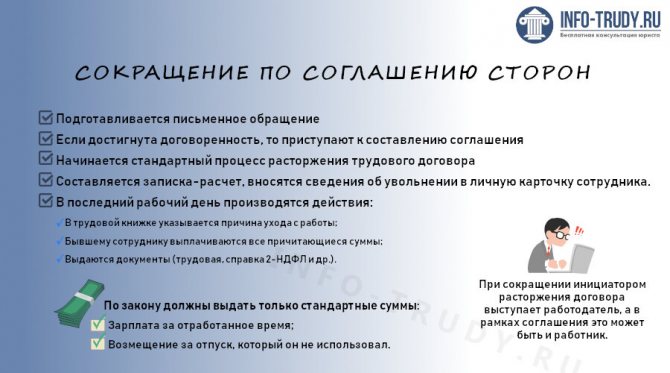Reduction
The Labor Code of the Russian Federation provides for 2 types of abbreviations:
- staff reduction;
- reduction in the number of employees.
In both cases, layoffs occur! If the staff is reduced, then a certain position is removed from the staffing table, and the employee occupying it is subject to dismissal.
Important
The layoff procedure is quite complicated; the employer needs to prepare a lot of documentation and carry out some mandatory activities. Deviation from the rules may lead to litigation and reinstatement of the previously dismissed person in his workplace.
The reduction procedure is as follows:
- timely written notification of all employees who are subject to layoffs;
- a written offer to them of vacancies that suit their level of education, work experience and health status;
- preparation of relevant personnel documents;
- timely calculation and payment of all necessary funds.
Termination of an employment contract at the initiative of the employer, in accordance with clause 2 of Art. 81 of the Labor Code of the Russian Federation provides for payment:
- wages;
- compensation for vacation that an employee did not have time to take off;
- severance pay in the amount of average monthly earnings (its payment is maintained for the period of employment, but no more than 2 months from the date of dismissal, more details).
Any employee can be laid off, with the exception of:
- female workers who have children under 3 years of age;
- employees who are on maternity leave - for pregnancy and childbirth or to care for their child;
- workers who have the official status of single mothers raising children under 14 years of age;
- employees on their annual leave or on sick leave;
- minor workers;
- employees who are members of a trade union and who are able to negotiate and resolve collective disputes;
- pregnant workers.
All the features and nuances of dismissal
At your own request
According to Russian legislation, every person is free to choose his work activity and change his place of work. The condition for leaving the organization may be the employee's initiative .
Everyone has the right to leave an organization at their own request, and the Labor Code of the Russian Federation, in force since 2002, has made it possible to simplify dismissal even for workers on a fixed-term contract. They don't have to give good reasons. The reason can be anything, and the law does not oblige you to report to management what prompted you to decide to quit.
The only time you really have to prove a good reason is if you need to leave without “working out ,” that is, continuing to work for a certain period (usually at least two weeks) after signing the application. If you have good reasons, “working out” can be avoided.
These reasons include:
- retirement or enrollment in an educational institution;
- violations of the law by the employer;
- moving;
- disease;
- baby care.
This is not a complete list of reasons that are considered valid. The Labor Code does not provide an article that would spell out all the options, so everything depends on the labor regulations of a particular organization. If your reason for leaving is not valid in the opinion of the employer, you can sue him in court.
There is only one condition for dismissal in this case – your desire. You must notify management in advance that you plan to leave your position, complete the established period, after which you may no longer appear at the workplace.
When an employer sets up obstacles (insists on completing the project, signing a work permit, etc.) and declares that he will not give up your work record, he is wrong and breaking the law.
Please note that you have the opportunity to resign on your own initiative during the vacation period. Here you have a choice between two options: submit an application for leave to your manager and at the same time give notice of dismissal, or send a letter of resignation to your employer while on vacation.
A pensioner has the right to leave the organization without working from the day on which he was assigned a pension.
You can also resign at will while on maternity leave or parental leave. You will not face any obstacles, and the manager will most likely not set two weeks of work for the absent person.
How does the dismissal process work? You are required to submit an application. The law does not provide for a strictly established form, but it is better not to complicate your life by composing a text, but to take a ready-made sample.
You can download a sample application here.
Who should apply? This depends on the rules of your organization. Somewhere the application is submitted to the manager, somewhere to the personnel department, and somewhere through the reception.
If a conflict situation arises, for example, they don’t want to sign your application, they lose it, or destroy it, you can protect yourself from troubles. Complete the application in two copies.
One is intended for the manager, and give the second to the HR specialist or secretary - you need the date on the application to be marked with the date it was received, the position and the signature with a transcript.
Sometimes even this method does not help, but there is another loophole: sending the application by mail. Please note that the letter must be registered, with notification and a list of attachments. Now you can easily prove in court that you submitted the application, because you have a document from the post office.
If you want to leave without working, and the employer asks you for documents proving that you have a good reason, he has the right to do so. Present the document or carry out your work duties for a couple more weeks.
If it turns out that you are sick, the period of work assigned to you is not interrupted. You will receive the money and labor you are entitled to while on sick leave.
After submitting your application, you have the right to change your mind , unless a new person has already been hired for your position. However, you cannot be replaced by a new employee against your will.
Make sure that the correct entry appears in the employment record: with the correct designation of the article and the reason for your departure. It must contain a reference to Art. 77 of the Labor Code of the Russian Federation and the text that you were dismissed at your own request or on the initiative of your manager.
All words are written in full, without abbreviations or abbreviations. If you see an inaccuracy in the work report, insist that a new entry be made. Before it, you need to indicate that the previous one is invalid.
Find out more about voluntary dismissal by watching the video:
By agreement of the parties
The most attractive difference of this type of dismissal is the speed of registration. You must negotiate your resignation with management and put the agreement in writing, but the law does not require you to give advance notice of your resignation.
Any party can initiate your resignation: both the employer and you. If you are the initiator, you do not need to justify your departure.
Both parties have the right to impose different conditions on each other. For example, you can agree on the resigning employee receiving compensation (severance pay) up to a specific amount, length of service, transfer of responsibilities to another person, and so on. It is important to remember that all conditions are recorded in the document, otherwise they are considered invalid.
Sample agreement of the parties with payment of compensation. Sample agreement of the parties without payment of compensation.
The employer may reject your initiative if he is not satisfied with the conditions. In such a situation, no one can force the other side, everyone is in an equal position. Neither you nor your employer have the right to suddenly “change your mind” without the consent of the other party.
You can resign in this way while on vacation, during illness or during a probationary period. For employees employed under a fixed-term contract, the same rules apply as for those who entered into an open-ended contract.
A pregnant employee also has the right to leave her position by agreement of the parties. True, if on the day the document was drawn up she did not yet know that she was pregnant, and then decided to remain in the organization, her actions are legal.
How does the dismissal procedure work? In the text of the application, write that you are resigning by agreement of the parties. Refer to the details of the agreement, otherwise your document is invalid. Please note that you must be notified in writing that an agreement has been drawn up. The document is signed by both parties.
You can download a sample letter of resignation by agreement of the parties here.
Don't be shy about asking for severance pay when management suggests you quit. Please note that the organization is not obliged to pay it, and the law does not provide for any minimum payment amount. This also applies to working out.
Accordingly, if you manage to reach a compromise with management, you can receive a good amount of money, and the employer can protect itself by setting conditions for your departure. In any case, you will receive money for unused vacation and salary.
If you and your employer have drawn up and signed a mutually beneficial agreement, and after some time one of you decides to introduce new conditions, changing the text of the document can only be done by mutual agreement.
If you have committed a violation, the most favorable option for you and the employer will be dismissal by agreement. You won’t ruin your reputation, and management won’t have to justify the legality of their decision.
Make sure that the text “dismissed by agreement of the parties, part 1 of article 77 of the Labor Code of the Russian Federation” appears in the labor report.
For all the benefits of dismissal by agreement of the parties, watch the video:
Pros and cons of layoffs for employers
For management, this process does not provide any advantages, except:
- Employees do not have the right to refuse dismissal. The initiative comes from the administration. If an employee is not satisfied with such a dismissal, then if the procedure is fully followed by his superiors, he has no legal opportunity to resist the dismissal;
- all compensation payments made by an enterprise in favor of laid-off employees reduce the tax base for income tax. If all documents are completed correctly, the employer will be able to significantly reduce the tax burden in this reporting period.
But this procedure also has its drawbacks. This:
- a strictly defined list of persons who cannot be dismissed by the administration;
- all payments in favor of laid-off workers “hit” the enterprise’s budget;
- the procedure itself is quite complicated. Any mistake may lead to legal proceedings.
Information
Therefore, before making a decision to downsize, you need to carefully think and weigh everything.
What are the risks and benefits of the downsizing procedure?
Most of the inconveniences for companies when carrying out headcount optimization through reduction are associated with a rather lengthy and complex procedure for its documentation. In addition, quite common mistakes made in practice by companies are:
- Termination of an employment contract with categories of persons whose dismissal is prohibited;
- The deadlines for warning about the planned reduction in numbers are violated;
- Available vacant positions are not offered to employees subject to dismissal.
Dismissal due to staff reduction is associated with additional financial costs for the company, since the employee must pay severance pay in the amount of average earnings for the month following the date of dismissal (see Article 178 of the Labor Code of the Russian Federation). In addition, the average earnings can be saved for the next month if the employee has not found a job and is officially registered with the employment service.
For your information
In exceptional cases, by decision of the employment service, benefits may be paid by the company for the third month after dismissal, if the former employee did not find a job.
Another very important point with this method of optimizing the number will be building communications with staff, preventing mass protests, strikes, and filing complaints with judicial and regulatory authorities.
Among the advantages of downsizing as a method of reducing the number of personnel, one should note the low likelihood of litigation if it is carried out competently and correctly. However, to do this, you must strictly comply with all legal requirements for this procedure.
If we consider the described option of dismissal from the employee’s point of view, then for him it also has a number of advantages, not counting the negative fact of losing his job, although in this case it is inevitable. So the employees who were laid off:
- Have the right to receive the above benefits for a period of up to 3 months after dismissal;
- Receiving unemployment benefits due to layoffs from the employment service (see paragraph 2 of article 3 of Law No. 1032-1).
Although these facts may seem like little consolation when taking into account the deprivation of earnings, it can nevertheless be stated that employees dismissed for other reasons do not have the right to such social guarantees.
For employers
Pros for employers:
- the initiative comes from the management team and as a result the employee cannot refuse to leave (for example, there is no vacancy or the employee is not satisfied with it);
- any compensation in this case automatically reduces the tax base (you will be able to pay less from the profit of an organization or enterprise).
Disadvantages for employers:
- the procedure takes a lot of time and requires precision at any of its stages;
- compensation payments create an additional burden on the enterprise’s budget;
- there is a possibility of challenge from the employee.
For employees
Benefits for employees:
- receiving additional accruals (severance pay, compensation);
- the opportunity to find a new place of work within two months after receiving the notice, without ceasing to work in the same place;
- there is a high probability of obtaining a vacant position at the same enterprise;
- preferential categories cannot be fired (pregnant employees, single mothers, minor workers).
Disadvantages for employees:
- it is impossible to avoid termination of the employment contract if a vacant position is not found;
- you will have to wait two months for the final payment and delivery of the work book.
Pros and cons of layoffs for an employee
Before deciding to dismiss due to reduction, the employee must evaluate all the advantages and disadvantages of this procedure. Positive aspects for the fired person include:
- 2 months notice. During this time, you can look for a new vacancy, view job advertisements;
- severance pay. It makes it possible to live for some time until the laid-off employee is re-employed;
- for 2 months his average earnings are retained;
- If a dismissed person registers with the Central Employment Service within 2 weeks, his average earnings will be retained for another month.
Don't forget about the negative sides. These include:
- this basis is less “respected” by personnel officers than dismissal on the initiative of the employee or by agreement of the parties;
- there is no possibility of avoiding dismissal;
The employee should think about future prospects. He can independently propose to his superiors to draw up a dismissal agreement and resign on this basis.
What is the best way to quit?
Regarding the financial issue , in any case you get:
- salary for the period worked (including the date of dismissal);
- compensation for vacation if you did not use it.
Read our article about what payments are made in case of dismissal by agreement of the parties.
Severance pay is provided only by agreement of the parties. This option is preferred by people in high positions, as they are more likely to receive a decent amount .
When management asks to resign by agreement of the parties in order to reduce employees, it is unprofitable to agree. This way, you may lose your redundancy compensation or receive a smaller amount.
If it happens that you have committed a serious violation in your work and are afraid of being fired under the article, dismissal by agreement of the parties can be a real salvation for your reputation.
By agreement of the parties
According to Art. 78 of the Labor Code of the Russian Federation, an employee and an employer may enter into an agreement among themselves to terminate relations between them. On this basis, the employment contract can be terminated at any time.
This procedure is more understandable to both the employee and his employer. This is the easiest way to end a relationship. But the main condition is an agreement reached between the employee and his boss regarding future dismissal.
Additionally
Employers often choose an agreement between the parties as an alternative to staff reductions.
The procedure is as follows:
- The parties begin negotiations regarding all the nuances of the upcoming dismissal. In order for an employee to agree to be dismissed by agreement, the employer must offer him something more profitable than he would receive with a layoff. As a rule, this is the amount of severance pay. It must be greater than or equal to what the employee receives by law;
- all agreements are set out on paper;
- the parties re-read the document again and sign it;
- the employee takes one copy for himself;
- an order is issued and the employment relationship is terminated.
Important
If the administration does not fulfill the obligations specified in the “body” of the agreement, the employee has the right to protect his rights in court.
What's the difference?
The main difference is in the initiator of dismissal. It could be you, or it could be the manager. If you leave of your own free will, no one has the right to restrict you. But if you have chosen a form of departure by agreement of the parties, you will need to seek a compromise with management.
If you agree, you don't have to tell us about your departure two weeks in advance. When you need to quit urgently, this option is ideal.
Dismissal by agreement of the parties provides an excellent chance to receive good monetary compensation from the organization. It will be especially easy to introduce such a condition if the initiator was the manager.
The text in the employment contract will vary (“dismissed by agreement of the parties” or “dismissed at his own request”). Both options will have no impact on your future career.
Dismissal by agreement of the parties: pros and cons for the employer
When offering his employee this method of terminating the employment relationship, the boss must understand that there are positive and negative sides.
The positive points include:
- simplicity of the process. There is nothing difficult in drawing up a draft agreement. But it should not violate the labor and civil rights of the employee. Otherwise, it will be declared invalid;
- it is almost impossible to win a case to terminate a contract in court, since the document is signed voluntarily;
- if the employee does not bother himself, then the administration may “forget” about paying severance pay;
- Any employee can be dismissed on this basis. There are no restrictions on age or marital status.
But there are also negative sides:
- No one can be fired without the employee’s consent. Consent is expressed in the form of a signature on the agreement;
- any compensation payments are made from the net profit of the enterprise. This burdens the budget and does not reduce the tax burden on income tax.
Dismissal during a pandemic
Unfortunately, in reality, businesses are suffering losses during the coronavirus period, which forces employers to optimize their expenses. Including resorting to layoffs. First of all, entrepreneurs with employees must find ways to preserve jobs by organizing remote work, providing vacations, or declaring forced downtime.
What is unacceptable in these circumstances is:
- groundless dismissal of employees: exerting pressure to terminate contracts at the initiative of employees or by agreement of the parties;
- violation of the rules for the reduction procedure: lack of warning about planned reductions, violation of restrictions on the dismissal of certain categories of citizens, etc.
If the organization has suspended its activities, then reductions are allowed only in the event of liquidation of the company.
It is worth remembering that employees who are on vacation or sick leave cannot be dismissed due to reduction until they actually return to work.
Pros and cons of dismissal by agreement of the parties for an employee
There are also positive and negative aspects for the employee. The advantages include:
- the ability to independently choose the period of termination of the contract. This will not necessarily be an immediate termination of the employment relationship. The employee can work another week, month or other period of time;
- the ability to independently choose the amount of compensation;
- the work book will indicate a more “respectful” entry than “reduction”;
- If, after leaving, the employee registers with the Employment Center, the amount of unemployment benefits will be slightly larger.
There are also disadvantages. This:
- the amount of compensation payments is determined by mutual agreement between the parties. The boss may not agree to pay what is provided for by law upon reduction;
- Having signed the agreement, the employee is practically deprived of the opportunity to win a case to terminate the agreement in court, since we are talking about its voluntary signing;
- The process of creating an agreement is not regulated by regulations. What the parties agreed on will be stated in the “body” of the document;
Prerequisites
A mandatory condition for terminating an employment relationship due to redundancy is compliance with the procedure:
- Initially, a dismissal order is generated. A list of employees subject to layoffs is carefully compiled. It excludes categories of persons designated by law - women who are pregnant or have children under 3 years of age, single mothers with a child under 14 years of age, highly qualified employees with good labor productivity indicators, etc. The priority right to keep them at work is regulated by Art. 179 TK.
- The next step is to inform the trade union, the employment service and directly dismissed workers about the procedure. Notification is provided in writing, at least 2 months before the planned termination of the contract.
- Employees who are laid off are offered alternative jobs within 2 months. If the person agrees, he is transferred to a new position. In this case, conditions may be worse than before.
- Upon dismissal, the employee is given labor documentation, salary, amount for unpaid vacation, and severance pay are accrued.
Violation of the conditions and procedure for terminating employment relations due to layoffs often ends in the employee going to court. This may lead to the dismissal being declared illegal, the person being reinstated in his position and compensation being paid to him for forced absence. The employer may be subject to penalties.
When dismissing an employee by agreement of the parties, the law sets forth the following conditions for the procedure:
- A written agreement must be reached between the employee and the management of the organization to terminate the employment relationship. Signatures indicate the voluntariness of the agreement and mutual approval of its terms.
- The agreement is drawn up arbitrarily, contains the date of termination of the contract, the amount of compensation if it is assigned.
- Informing the trade union and employment service about the process is not required. The algorithm for completing the procedure is standard - an order is drawn up, which the employee reads and signs. On the final day of work, he is paid and given working documentation.
Since the conclusion of an agreement implies mutual expression of will, it is extremely difficult for an employee to challenge it in the future in court.
What should an employee choose?
There is no clear answer to this question; it all depends on the specific situation. If you have doubts regarding the choice of dismissal method, then it is worth weighing the pros and cons.
If there are no reasons to doubt the employer’s honesty and integrity, if the employee is absolutely sure that in this way the boss is simply making his task easier, then you can calmly agree to terminate the employment contract under Art. 78 Labor Code of the Russian Federation.
If there are doubts that the employer simply wants to pay smaller amounts of money, then you should think twice before agreeing to dismissal by mutual agreement.
Important
In any case, the employee has to make a choice based on each specific situation. A situation may arise that the parties do not reach an agreement. Therefore, you need to proceed from the specific circumstances of the dismissal.
What is the best way for an employee to quit and what is more beneficial for the future retiree?
It is recommended to choose which option for terminating the employment relationship is better based on the specific situation. Dismissal due to reduction provides the employee with financial guarantees in case of problems with employment. However, termination of the contract by agreement may be more profitable if an agreement is reached with the employer on a high amount of compensation.
The consent of the parties is considered a more peaceful way to sever the working relationship and does not create problems with further employment. A layoff presupposes that there is a negative reason why the employee was on the layoff list, which can cause difficulties when finding a new job.
Dismissal due to reduction is beneficial to employees before retirement , since it allows them to apply for early retirement with the help of the employment service (Article 32 of the Law on Employment).
Employers prefer to cancel an employment contract by agreement of the parties, since this frees them from paperwork, shortens the process, makes it possible to avoid material costs and dismiss persons belonging to preferential categories.
The employee is advised to evaluate the proposed conditions - in most cases, reduction is more profitable in material terms .
If the company’s management only wants to simplify the dismissal process without harming the employee, and the conditions suit both parties, it is advisable to enter into an agreement. One of the significant advantages of this option for employees is the opportunity to receive all funds due from the employer at once.
Dismissal at your own request
Today, this formulation of dismissal is the most popular. This basis is enshrined in Article 80 of the Labor Code of the Russian Federation. An employee’s decision to resign on his own initiative can be preceded by a lot of life circumstances - moving, moving to work for another employer, family responsibilities, retirement, entering universities, etc.
Important
The main positive aspect of terminating an employment contract on this basis for a worker is that the employer has no right to refuse him this desire.
Sometimes management, in its desire to retain a valuable employee, simply refuses to accept his application, but this problem is easily solved - you need to send the document by registered mail with an attached inventory, and then the employer will have no choice but to pay the employee.
The dismissal procedure under Art. 80 Labor Code of the Russian Federation standard:
- the employee draws up a written application addressed to the head of the organization with a demand to terminate the employment contract with him. The application is submitted to the personnel service, or, if there is a suspicion that it will not be accepted in this form, you can send it by registered mail with an enclosed inventory;
- The duty of an employee who resigns voluntarily is to work for the employer for two weeks. This period is provided to the company to find a new employee to replace the departing one;
- the actual dismissal itself is the signing of a dismissal order, receipt of a work book, unpaid wages and compensation for unused vacations.
It is worth noting that two-week work is not always a mandatory stage in this case. If both parties do not mind, the contract can be terminated earlier. In addition, there is a category of persons from among the working personnel whom the head of the organization does not have the right to refuse to terminate the contract on the date they want:
- pensioners;
- students admitted to educational institutions as full-time students;
- wives of military personnel serving with their husband to his new duty station, etc.
Required documents and conditions
In order to make a reduction by agreement of the parties, the following papers will be needed.
A document containing a proposal for dismissal by agreement - its form depends on who is the initiator of this procedure:
- If this is an employee, then a statement is written to the head of the organization containing a request to cancel the employment contract under clause 1 of Art. 77 Labor Code of the Russian Federation;
- If the employer, then a corresponding service letter is sent to the specific employee.
A written agreement - a single sample - has not been approved at the legislative level. Typically, this document contains the following information:
- Details of the employment contract;
- A record of mutual agreement between the employee and management;
- Date of dismissal and grounds according to the Labor Code of the Russian Federation;
- The amount of additional compensation that will be paid to the personnel (if this has been discussed);
- The period during which the full payment will be made (last business day);
- A note indicating that there are no claims between the parties to the agreement.
It is drawn up in 2 copies, one of which remains with the employer, and the second is issued to the employee.
Additionally, it is worth noting that drawing up an agreement is not a prerequisite. As judicial practice shows, to carry out such a procedure, an application from the employee and a corresponding order from the employer are sufficient.









